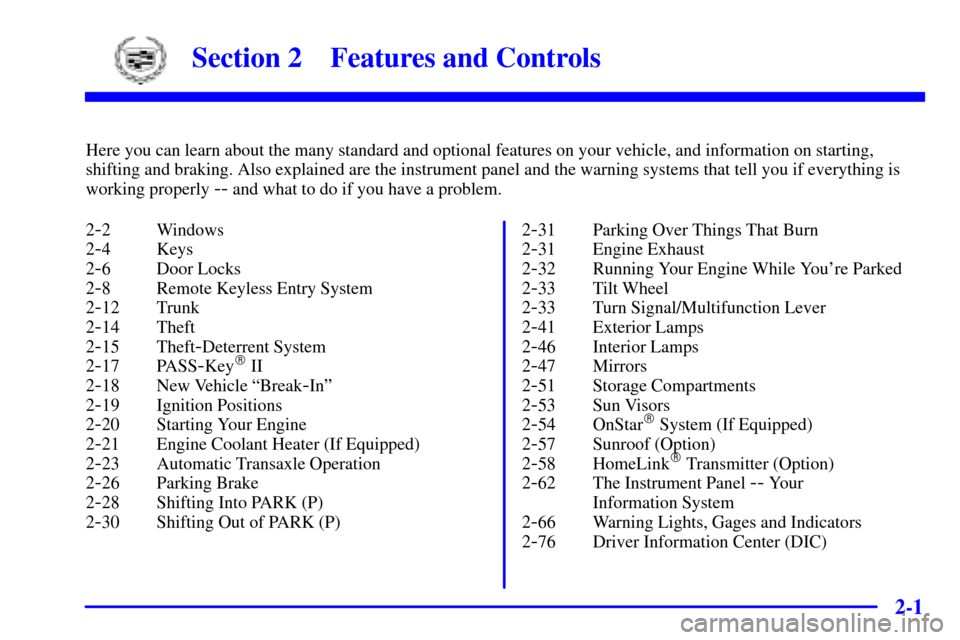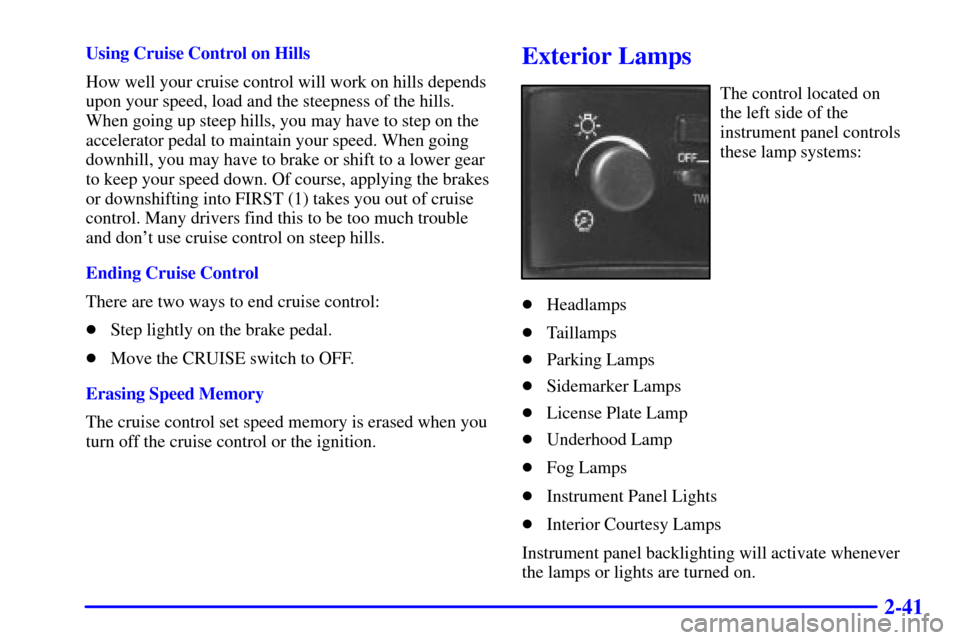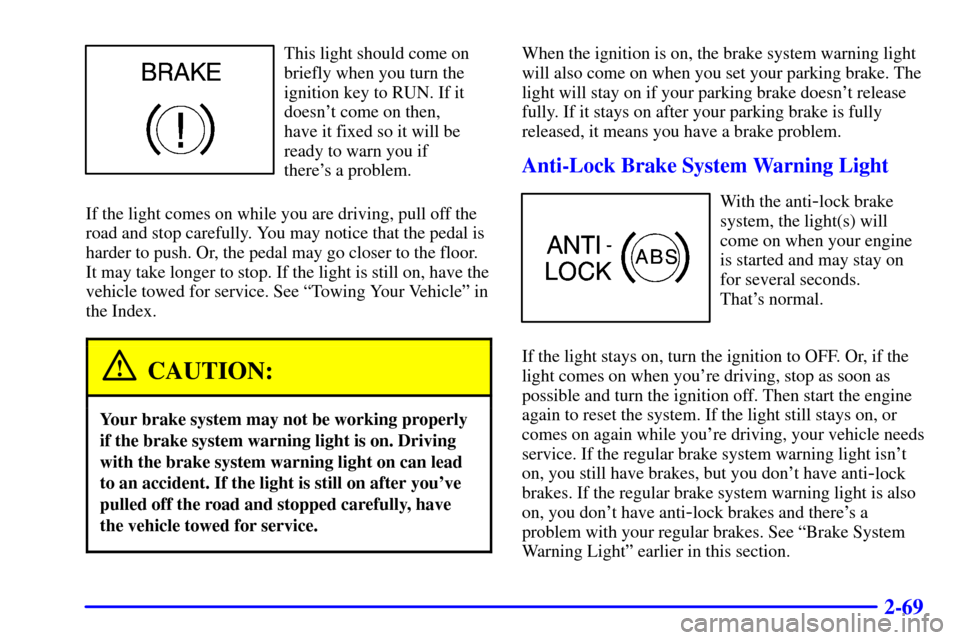Page 4 of 335
ii
Table of Contents
Windows
Keys and Door Locks
Remote Keyless Entry System
Trunk Release
Automatic Transaxle
Parking Brake
Tilt Wheel
Turn Signal/Multifunction Lever
Windshield Wipers
Cruise Control
Exterior and Interior LampsMirrors
Storage Compartments
Convenience Net
Accessory Power Outlets
OnStar® System (If Equipped)
Sunroof (Option)
HomeLink® Transmitter (Option)
Instrument Panel, Warning Lights and Gages
Driver Information Center
Memory and Personalization Features (If Equipped) Seats and Seat Controls
Safety BeltsAir Bag Systems
Restraint Systems for Children
Section
1
Section
2
Seats and Restraint Systems
Features and Controls
Page 11 of 335

ix
For example,
these symbols
are used on an
original battery:
CAUTION
POSSIBLE
INJURY
PROTECT
EYES BY
SHIELDING
CAUSTIC
BATTERY
ACID COULD
CAUSE
BURNS
AVOID
SPARKS OR
FLAMES
SPARK OR
FLAME
COULD
EXPLODE
BATTERY
These symbols
are important for
you and your
passengers
whenever your
vehicle is driven:
CHILD
RESTRAINT
TOP STRAP
ANCHOR
DOOR LOCK
UNLOCK
FASTEN
SEAT
BELTS
POWER
WINDOW
AIR BAG
These symbols
have to do with
your lamps:
MASTER
LIGHTING
SWITCH
TURN
SIGNALS
PARKING
LAMPS
HAZARD
WARNING
FLASHER
DAYTIME
RUNNING
LAMPS
FOG LAMPS
These symbols
are on some of
your controls:
WINDSHIELD
WIPER
WINDSHIELD
WASHER
WINDSHIELD
DEFROSTER
REAR
WINDOW
DEFOGGER
VENTILATING
FAN
These symbols
are used on
warning and
indicator lights:
ENGINE
COOLANT
TEMP
BATTERY
CHARGING
SYSTEM
BRAKE
COOLANT
ENGINE OIL
PRESSURE
ANTI-LOCK
BRAKES
Here are some
other symbols
you may see:
FUSE
LIGHTER
HORN
FUEL
Vehicle Symbols
These are some of the symbols you may find on your vehicle. Also see ªWarning Lights and Gagesº in the Index.
Page 62 of 335

2-
2-1
Section 2 Features and Controls
Here you can learn about the many standard and optional features on your vehicle, and information on starting,
shifting and braking. Also explained are the instrument panel and the warning systems that tell you if everything is
working properly
-- and what to do if you have a problem.
2
-2 Windows
2
-4 Keys
2
-6 Door Locks
2
-8 Remote Keyless Entry System
2
-12 Trunk
2
-14 Theft
2
-15 Theft-Deterrent System
2
-17 PASS-Key� II
2
-18 New Vehicle ªBreak-Inº
2
-19 Ignition Positions
2
-20 Starting Your Engine
2
-21 Engine Coolant Heater (If Equipped)
2
-23 Automatic Transaxle Operation
2
-26 Parking Brake
2
-28 Shifting Into PARK (P)
2
-30 Shifting Out of PARK (P)2
-31 Parking Over Things That Burn
2
-31 Engine Exhaust
2
-32 Running Your Engine While You're Parked
2
-33 Tilt Wheel
2
-33 Turn Signal/Multifunction Lever
2
-41 Exterior Lamps
2
-46 Interior Lamps
2
-47 Mirrors
2
-51 Storage Compartments
2
-53 Sun Visors
2
-54 OnStar� System (If Equipped)
2
-57 Sunroof (Option)
2
-58 HomeLink� Transmitter (Option)
2
-62 The Instrument Panel -- Your
Information System
2
-66 Warning Lights, Gages and Indicators
2
-76 Driver Information Center (DIC)
Page 87 of 335
2-26
FIRST (1): This position gives you even more power
than SECOND (2). You can use it on very steep hills,
or in deep snow or mud. (If the shift lever is put in
FIRST (1), the transaxle won't shift into gear until the
vehicle is going slowly enough.)
NOTICE:
If your front wheels can't rotate, don't try to
drive. This might happen if you were stuck in
very deep sand or mud or were up against a solid
object. You could damage your transaxle.
Also, if you stop when going uphill, don't hold
your vehicle there with only the accelerator
pedal. This could cause overheating and damage
the transaxle. Use your brakes to hold your
vehicle in position on a hill.
Parking Brake
Hold the regular brake
pedal down with your right
foot and push down the
parking brake pedal with
your left foot to set the
parking brake.
If the ignition is on, the BRAKE indicator light
should come on. If it doesn't, you need to have
your vehicle serviced.
Page 88 of 335

2-27
If the parking brake has not been fully released and
you try to drive with the parking brake on, the
BRAKE indicator light comes on and stays on.
See ªBrake System Warning Lightº in the Index for
more information.
When you move out of PARK (P) or NEUTRAL (N),
if the engine is running, the parking brake should
release. If it doesn't, you can manually release the
parking brake.
CAUTION:
Always shift to PARK (P) before pulling the
manual release lever. If your hand or arm is in
the way of the pedal you could be hurt. The pedal
springs back quickly. Keep your hand and arm
away when you use the manual release lever.
Be sure to turn off the ignition and put the vehicle in
PARK (P) before manually releasing the brake.
Reach under the driver's side of the instrument panel
and pull on the manual release lever, which is located
above the parking brake pedal. If the parking brake does
not release, you should either drive to the nearest service
station or have your vehicle towed.
Page 102 of 335

2-41
Using Cruise Control on Hills
How well your cruise control will work on hills depends
upon your speed, load and the steepness of the hills.
When going up steep hills, you may have to step on the
accelerator pedal to maintain your speed. When going
downhill, you may have to brake or shift to a lower gear
to keep your speed down. Of course, applying the brakes
or downshifting into FIRST (1) takes you out of cruise
control. Many drivers find this to be too much trouble
and don't use cruise control on steep hills.
Ending Cruise Control
There are two ways to end cruise control:
�Step lightly on the brake pedal.
�Move the CRUISE switch to OFF.
Erasing Speed Memory
The cruise control set speed memory is erased when you
turn off the cruise control or the ignition.Exterior Lamps
The control located on
the left side of the
instrument panel controls
these lamp systems:
�Headlamps
�Taillamps
�Parking Lamps
�Sidemarker Lamps
�License Plate Lamp
�Underhood Lamp
�Fog Lamps
�Instrument Panel Lights
�Interior Courtesy Lamps
Instrument panel backlighting will activate whenever
the lamps or lights are turned on.
Page 129 of 335

2-68
CAUTION:
If the air bag readiness light stays on after you
start your vehicle, it means the air bag system
may not be working properly. The air bags in
your vehicle may not inflate in a crash, or they
could even inflate without a crash. To help avoid
injury to yourself or others, have your vehicle
serviced right away if the air bag readiness light
stays on after you start your vehicle.
The air bag readiness light should flash for a few
seconds when you turn the ignition key to RUN. If the
light doesn't come on then, have it fixed so it will be
ready to warn you if there is a problem.
Charging System Indicator Light
When you turn the ignition
key to RUN, this light will
come on briefly to show
that the generator and
battery charging systems
are working.
If this light stays on, you need service and you should
take your vehicle to the dealer at once. To save your
battery until you get there, turn off all accessories.
Brake System Warning and Park Brake
Indicator Light
Your vehicle's hydraulic brake system is divided into
two parts. If one part isn't working, the other part can
still work and stop you. For good braking, though, you
need both parts working well.
If the warning light comes on, there is a brake problem.
Have your brake system inspected right away.
Page 130 of 335

2-69
This light should come on
briefly when you turn the
ignition key to RUN. If it
doesn't come on then,
have it fixed so it will be
ready to warn you if
there's a problem.
If the light comes on while you are driving, pull off the
road and stop carefully. You may notice that the pedal is
harder to push. Or, the pedal may go closer to the floor.
It may take longer to stop. If the light is still on, have the
vehicle towed for service. See ªTowing Your Vehicleº in
the Index.
CAUTION:
Your brake system may not be working properly
if the brake system warning light is on. Driving
with the brake system warning light on can lead
to an accident. If the light is still on after you've
pulled off the road and stopped carefully, have
the vehicle towed for service.
When the ignition is on, the brake system warning light
will also come on when you set your parking brake. The
light will stay on if your parking brake doesn't release
fully. If it stays on after your parking brake is fully
released, it means you have a brake problem.
Anti-Lock Brake System Warning Light
With the anti-lock brake
system, the light(s) will
come on when your engine
is started and may stay on
for several seconds.
That's normal.
If the light stays on, turn the ignition to OFF. Or, if the
light comes on when you're driving, stop as soon as
possible and turn the ignition off. Then start the engine
again to reset the system. If the light still stays on, or
comes on again while you're driving, your vehicle needs
service. If the regular brake system warning light isn't
on, you still have brakes, but you don't have anti
-lock
brakes. If the regular brake system warning light is also
on, you don't have anti
-lock brakes and there's a
problem with your regular brakes. See ªBrake System
Warning Lightº earlier in this section.